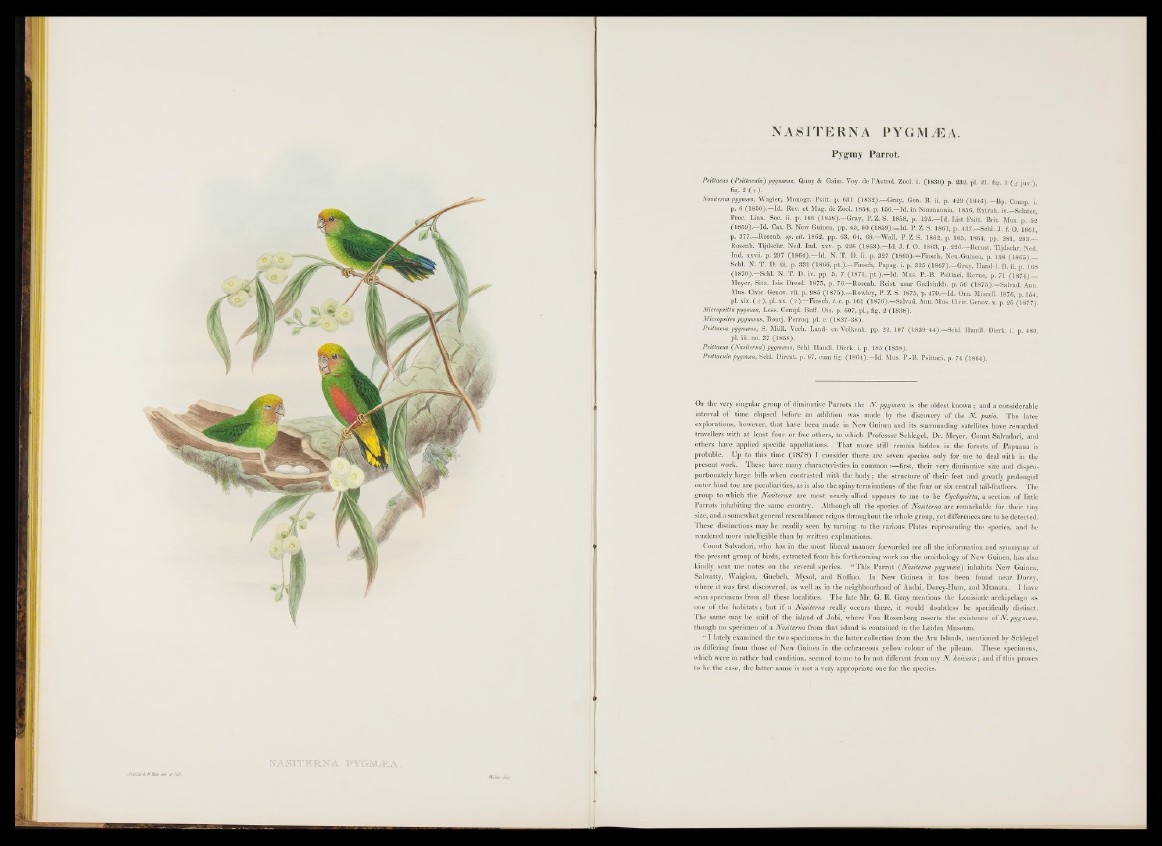
Pygmy Parrot.
Psittacus ( Psittacula) pygmeeus, Quoy & Gaim. Voy. de l’Astrol. Zool. i. (1830) p. 232, pi. 21. fig. 1 (<y juv.),
fig- 2 ( ? ) • .
Nasiterna pygmasa, Wagler, Monogr. Psitt. p. 631 (1832).—Gray, Gen. B. ii. p. 423 ( 1 8 4 6 ) . — Bp. Consp. i.
p. 6 (1850).—Id. Rev. et Mag. de Zool. 1854, p. 156—Id. in Naumannia, 1856, Extrah. iv.—Sclater,
Proc. Linn. Soc. ii. p. 166 (1858).—Gray, P. Z. S. 1858, p. 195.—Id. List Psitt. Brit. Mus. p. 52
(1859).—Id. Cat. B. New Guinea, pp. 43, 60 (1859)—Id. P. Z.S. 1861, p. 437.—Schl. J. f. 0 . 1861,
p. 377—Rosenb. op. cit. 1862, pp. 63, 64, 68.—Wall. P. Z.S. 1862, p. 165, 1864, pp. 281, 293.—
Rosenb. Tijdscbr. Ned. Ind. xxv. p. 226 (1863).—Id. J. f. O. 1863, p. 226.—Bernst. Tijdschr. Ned.
Ind. xxvii. p. 297 (1864).—Id. N. T. D. ii. p. 327 (1865).—Finsch, Neu-Guinea, p. 158 (1865)._
Schl. N. T. D. iii. p. 331 (1866, pt.).—Finsch, Papag. i. p. 325 (1867).—Gray, Hand-1. B. ii. p. 168
(1870).—Schl. N. T. D. iv. pp. 5, 7 (1871, pt.).—Id. Mus. P.-B. Psittaci, Revue, p. 71 (1874).—
Meyer, Sitz. Isis Dresd. 1875, p. 76.—Rosenb. Reist, naar Geelvinkb. p. 56 (1875).—Salvad. Ann.
Mus. Civic. Genov, vii. p. 985 (1875).—Rowley, P. Z. S. 1875, p. 470.—Id. Orn. Miscell. 1876, p. 15 4 ,
pi. xix. (<?), pi. xx. ($ ).—Finsch, t. c. p. 161 (1876).—Salvad. Ann. Mus. Civic. Genov, x. p. 25 (1877).
Micropsitta pygmaa, Less. Compl. Butf. Ois. p. 607, pi., fig. 2 (1838).
Micropsites pygmeeus, Bourj. Perroq. pi. c. (1837-38).
Psittacus pygmeeus, S. Müll. Verh. Land- en Volkenk. pp. 22, 107 (1839-44).—Schl. Handl. Dierk. i. p. 480,
pi. iii. no. 37 (1858).
Psittacus (Nasiterna) pygmeeus, Schl. Handl. Dierk. i. p. 185 (1858).
Psittacula pygmaa, Schl. Dirent. p. 67, cum fig. (1864).—Id. Mus. P.-B. Psittaci, p. 74 (1864).
O f the very singular group o f diminutive Parrots the N . pygmasa is the oldest known; and a considerable
interval o f time elapsed before an addition was made by the discovery o f the N . pusio. The later
explorations, however, that have been made in New Guinea and its surrounding satellites have rewarded
travellers with a t least four or five others, to which Professor Schlegel, Dr. Meyer, Count Salvadori, and
others have applied specific appellations. That more still remain hidden in the forests o f Papuana is
probable. Up to this time (1 8 7 8 ) I consider there are seven species only for me to deal with in the
present work. These have many characteristics in common:— first, their very diminutive size and disproportionately
large bills when contrasted with the bod y ; the structure o f their feet and greatly prolonged
outer hind toe are peculiarities, as is also the spiny terminations o f the four or six central tail-feathers. The
group to which the Nasiternee are most nearly allied appears to me to be Cyclopsitta, a section o f little
Parro ts inhabiting the same country. Although all the species o f Nasiterna are remarkable for their tiny
size, and a somewhat general resemblance reigns throughout the whole group, yet differences are to be detected.
These distinctions may be readily seen by turning to the various Plates representing the species, and be
rendered more intelligible than by written explanations.
Count Salvadori, who has in the most liberal manner forwarded me all the information and synonymy of
the present group o f birds, extracted from his forthcoming work on the ornithology o f New Guinea, has also
kindly sent me notes on the several species. “ This Parro t ( Nasiterna pygmeea) inhabits New Guinea,
Salwatty, Waigiou, Guebeh, Mysol, and Koffiao. In New Guinea it has been found near Dorey,
where it was first discovered, as well as in the neighbourhood o f Andai, Dorey-Hum, and Mtanata. I have
seen specimens from all these localities. The late Mr. G. R. Gray mentions the Louisiade archipelago as
one o f the h a b ita ts ; but if a Nasiterna really occurs there, it would doubtless be specifically distinct.
The same may be said o f the island of Jobi, where Von Rosenberg asserts the existence o f N . pygmcea,
though no specimen o f a Nasiterna from th at island is contained in the Leiden Museum,.
“ I lately examined the two specimens in the latter collection from the Aru Islands, mentioned by Schlegel
as differing from those o f New Guinea in the ochraceous yellow colour o f the pileum. These specimens,
which were in rath e r bad condition, seemed to me to be not different from my N . keiensis\ and if this proves
to be the case, the latter name is not a very appropriate one for the species.